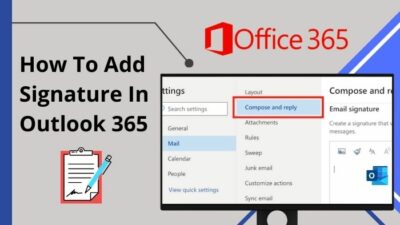If you’re a frequent Outlook user or work in an organization, you may receive a good number of emails every day. Your mailbox is getting loaded, and apparently, you’re on the edge of meeting an unexpected guest.
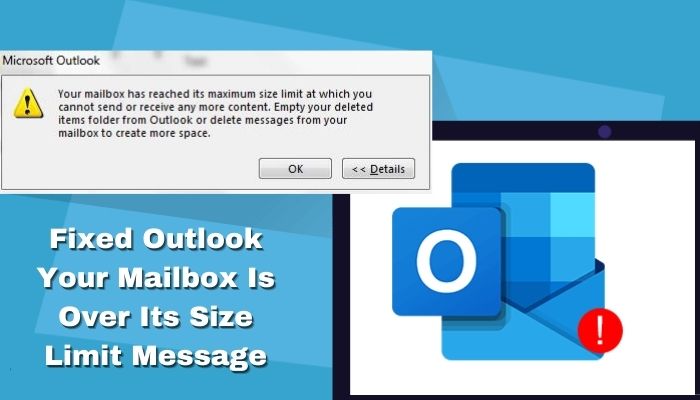
One fine morning, you started working in Outlook and suddenly received an error message saying Your mailbox is over its size limit. It becomes annoying when you discover that you can’t send or receive any emails.
Well, I’ve also faced the same problem once. This error appears when your mailbox occupies all the default allocated space and reaches the maximum limit. But, you can free up the space in a short time without deleting any emails.
This article will explain everything you need to know to resolve the size limit issue. Let’s start.
Why is My Outlook Mailbox Over Its Size Limit?
You are receiving a mailbox size limit error message because of running Outlook on a Microsoft Exchange server, using an outdated OST file, or your Outlook has exceeded the default mailbox size. Additionally, Microsoft quota program issues can affect the size limit and show error messages.
You will find an extensive explanation of the reasons in the following passage. Read them to know about the cause correctly.
Here are the reasons behind the mailbox over size limit issue:
Running Outlook on Exchange Server
Exchange server mailbox limits can be configured, and your email messages and items are delivered and saved in the Exchange server mailbox when using an Exchange account. If the mailbox size exceeds, you will receive an error message in Outlook.
Using an Older Outlook Data File Version
An old or corrupted data file stops the mailbox synchronization and prevents you from accessing the mailbox items, such as emails, contacts, and attachments. When the synchronization process fails, you may face the mailbox size limit exceeding the error message.
Outlook File has Exceeded Default Size
Every Outlook version has a default size for the mailbox. You’re receiving a size limit error message because the mailbox has already filled the allocated space.
Quota Management Program Issue
Mailbox quotas are applied to the users based on the default values of the quotas on their Microsoft Exchange mailbox server databases. The quota program may face issues; thus, you receive a size limit error message.
Mailbox usually contains emails and items of your personal and organization. We’ve seen users face problems with the mailbox size. But, they don’t want to delete or have doubts about deleting them. They have legitimate reasons behind the issues.
However, you can effortlessly make space in your mailbox without deleting important emails or items. The following article will help you resolve your Outlook mailbox’s size limit issue.
Read our new guide post on how to View Message Headers in Outlook.
How to Fix Outlook/Office 365 Error Message ‘Your Mailbox is Over Its Size Limit’?
You can resolve the size limit error message in Outlook by using the cleanup tools, deleting duplicate items, and compacting Outlook data files. You can archive or create a personal folder to move your items from the mailbox. Also, you can increase the mailbox size by modifying the registry editor.
Consider reading the entire article to fix the mailbox size exceeded error and learn about the mailbox cleanup process and the technique to increase mailbox size.
Here are the ways to fix your mailbox is over its size limit error message:
1. Mailbox Cleanup
Mailbox cleanup is a built-in Outlook cleanup utility that allows you to reduce your mailbox space. You can sort your mailbox by date and size and delete them to free up your mailbox. The procedure is very effortless and helpful. To clean up your mailbox, follow the procedure below.
Here are the procedures to clean up the Outlook mailbox:
- Open your Outlook application.
- Go to File from the top left corner.
- Press on Cleanup Tools from the Info section.
- Tap on Mailbox Cleanup.
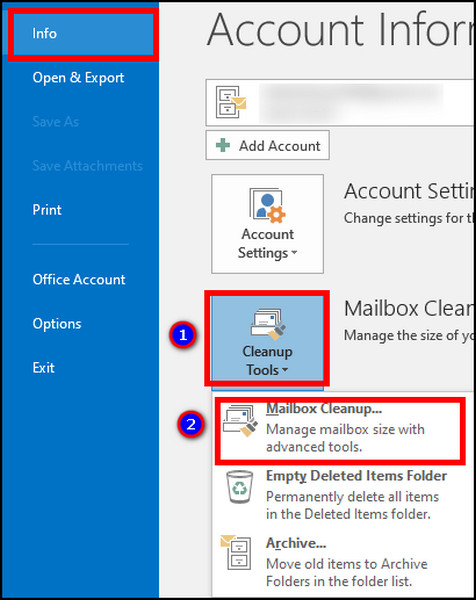
- Select Find items older than or Find items larger than option and press on Find.
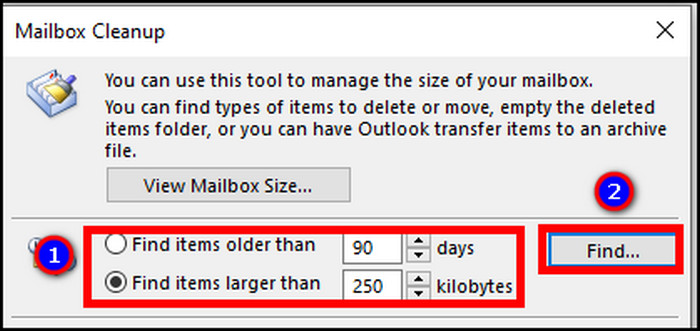
- Delete the items you want from the list.
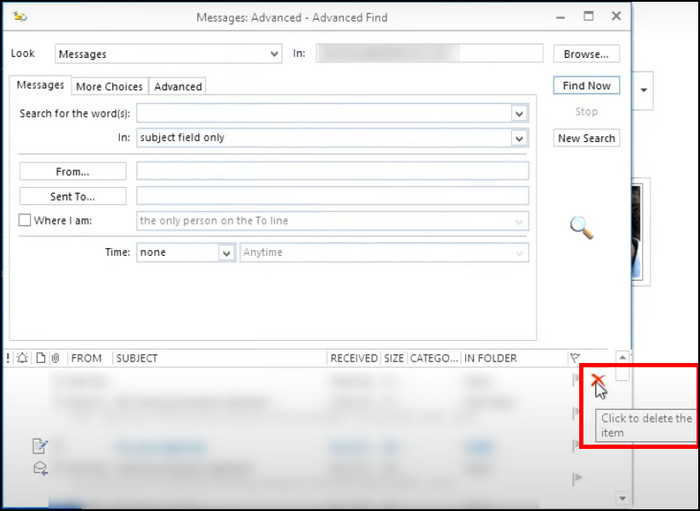
Deleting an item won’t reduce your mailbox space until you permanently delete them from your deleted items folder.
Here is the process to empty the deleted items folder:
- Tap on File.
- Click on Cleanup Tools from the Info tab.
- Select the Mailbox Cleanup option.
- Press on Empty to remove all the items in the deleted items folder.
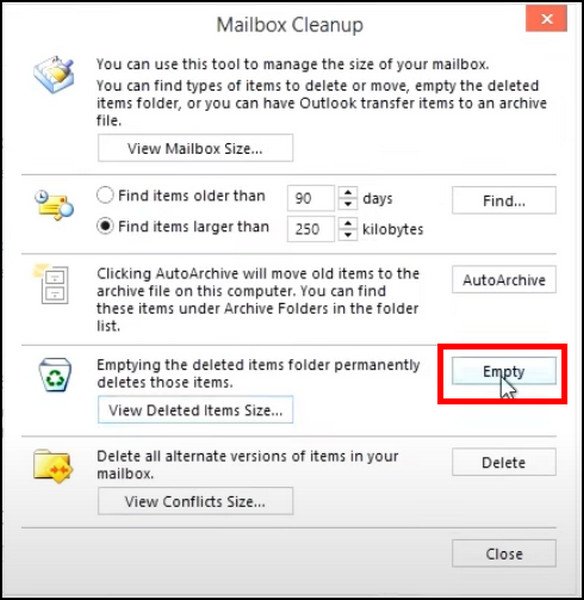
It will permanently remove the items from your mailbox. Deleting an item permanently will reduce your mailbox space.
Also, read how to Fix Outlook Not Connecting to Server Error.
2. Delete the Duplicate Items
Sometimes you create duplicate items for various purposes or receive the same items multiple times. Duplicate items are unnecessary and occupy your valuable space in the mailbox. Finding the duplicate items manually would be a hassle. But, you can see and delete all the alternate versions from the Mailbox Cleanup section.
Here is the process to delete duplicate items from the mailbox:
- Go to File.
- Tap on Cleanup Tools.
- Choose Mailbox Cleanup.

- Press on View Conflicts Size to see the duplicate item size.
- Click on Delete to remove the duplicate items from your mailbox.

3. Modify Registry Editor
Wouldn’t it be fantastic to be able to increase the mailbox size? Well, you can increase the mailbox size of your Outlook apps by tweaking the registry editor. But, be careful when you are modifying the registry. Read the steps cautiously to increase the mailbox size.
Here are the steps to increase mailbox size by modifying the registry editor:
- Press Win + R together to open the Run dialog box.
- Type regedit and press OK.
- Tap on Yes to give modification permission.
- Navigate to the following location according to your Outlook version.
- Outlook 2002: HKEY_CURRENT_USER\Software\Policies\Microsoft\Office\11.0\Outlook\PST
- Outlook 2007: HKEY_CURRENT_USER\Software\Policies\Microsoft\Office\12.0\Outlook\PST
- Outlook 2010: HKEY_CURRENT_USER\Software\Policies\Microsoft\Office\14.0\Outlook\PST
- Outlook 2013: HKEY_CURRENT_USER\Software\Policies\Microsoft\Office\15.0\Outlook\PST
- Outlook 2016: HKEY_CURRENT_USER\Software\Policies\Microsoft\Office\16.0\Outlook\PST
- Create two DWORD (32-bit) Value files at the right pane named MaxLargeFileSize and WarnLargeFileSize.

- Double-click on MaxLargeFileSize and set the base to Decimal, and put a preferred value.
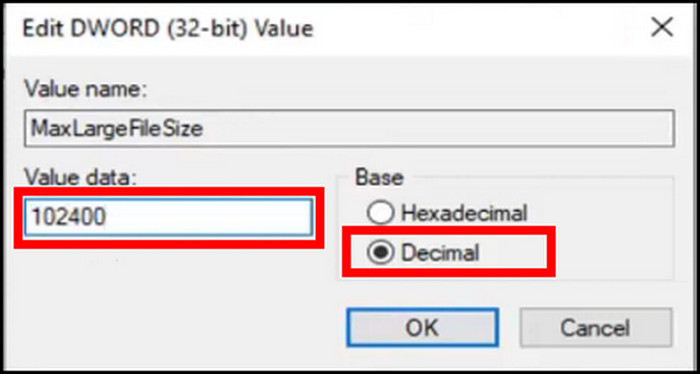
- Double-click on WarnLargeFileSize and choose Decimal from the base, and put your preferred value in the box.
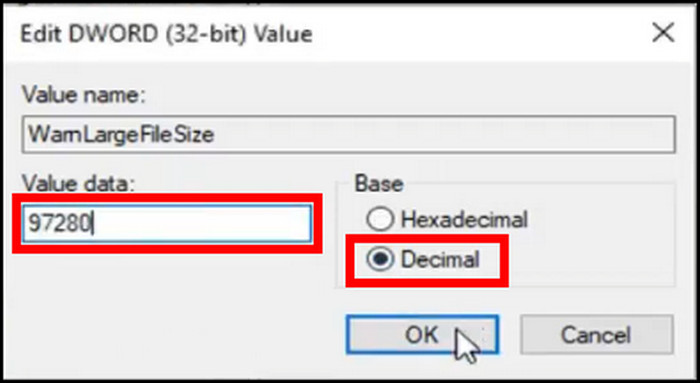
Values in MaxLargeFileSize and WarnLargeFileSize are in Megabytes (MB). Make sure your available space is in the hard drive before putting the value.
WarnLargeFileSize values are generally 95% of MaxLargeFileSize. But, you can put any number less than the value of MaxLargeFileSize.
Also, check our new guide post Outlook: The Home Menu is Missing.
4. Compact the Outlook Data File
If you want to reduce the size of a data file, you can use the built-in compact feature to shrink the file. To compact your Outlook OST or PST data file, follow the steps below.
Here are the steps to compact the Outlook data file:
- Open Outlook apps.
- Tap on File from the left top corner.
- Go to Account Settings.
- Select Account Settings.
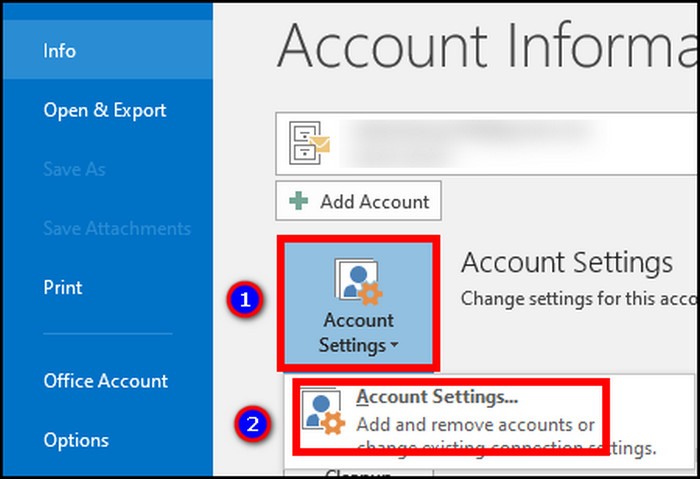
- Navigate to Data Files.
- Select the data files you want to compact.
- Press on Settings.
- Click on Compact Now.
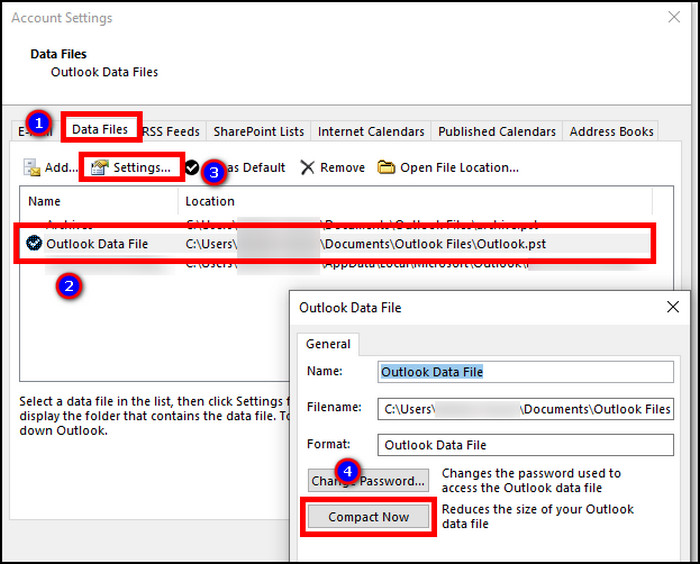
The process will minimize your data file size and open up some space in the mailbox.
Check out our separate post on Outlook: Enable or Disable Macros.
5. Archive Data File
Your emails and items in the mailbox can be crucial. You need to free up the space, but you can’t delete them for legal and valid reasons. That’s where the archive feature comes in. You can archive and reduce the mailbox space without deleting the mailbox items.
Here is the procedure to archive mailbox data files:
- Launch your Outlook application.
- Press on the File.
- Tap on Cleanup Tools.
- Click on the Archive archive option.

- Select a folder or tap on the account name to select all folders.
- Choose a date from the Archive items older than option.
- Browse and select your archive file location.
- Press on OK to archive the mailbox.
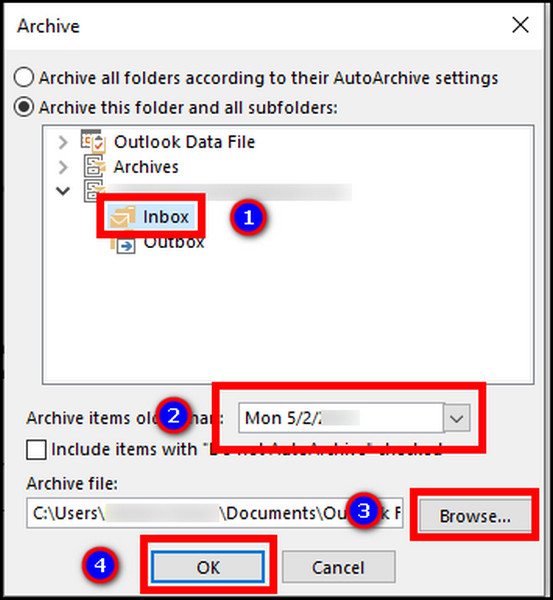
Archiving the items will free up the space in your mailbox. If you want to access the archived data, you’ll find them in the Archives folder from the left pane.
6. Create a Personal Folder
Personal folders are similar to archives. But, you have more control and can manually move items to your personal folders. Personal folders are created on your PC, and moving an item to it frees up the space in the mailbox.
Here are the procedures to create a personal folder:
- Select File from your Outlook PC.
- Press on Account Settings.
- Tap on Account Settings again.

- Go to the Data Files section.
- Click on the Add button.
- Choose the file location and set a file name.
- Press on OK to confirm.
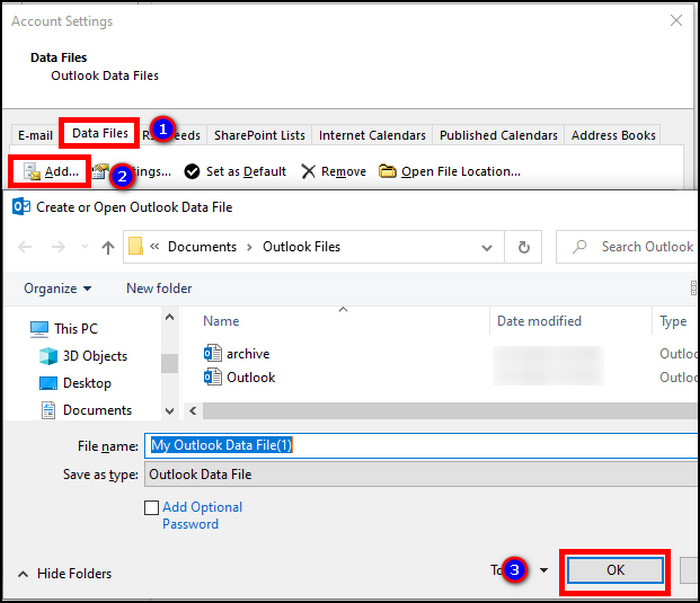
You will see the personal folder on the left pane of your home screen. You can drag any items to your personal folder to clear up the space in the Outlook mailbox.
Check out the easiest way how to Enable Read Receipts In Outlook.
Frequently Asked Questions
What does it mean when Outlook says mailbox is full?
Outlook shows the mailbox is full when your mailbox has reached the maximum storage limit.
How do I free up space in Outlook without deleting emails?
You can archive data files or create a personal folder to free up space in Outlook without deleting emails.
Do archived emails stay forever?
Archived emails only get removed from the inbox and transferred to your local computer. They will remain there indefinitely if you don’t delete them manually.
Final Thoughts
The newer Outlook version offers more space in the mailbox than previous versions. Currently, users receive 50 GB of mailbox space, whereas Outlook 2002 has provided only 2 GB of mailbox space.
Our demand is increasing, and no provided space is enough. At some point, you’ll need to free up the mailbox to keep the email flow active.
I hope you’ve benefited by reading this article, keeping your mailbox clean and tidy, and backing up your important emails.
Cheers!

